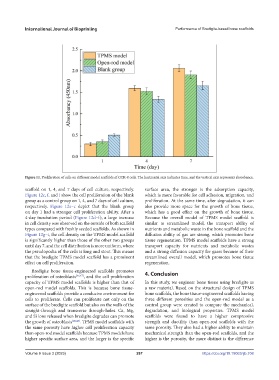Page 275 - IJB-9-3
P. 275
International Journal of Bioprinting Performance of Bredigite-based bone scaffolds
Figure 11. Proliferation of cells on different model scaffolds of CCK-8 cells. The horizontal axis indicates time, and the vertical axis represents absorbance.
scaffold on 1, 4, and 7 days of cell culture, respectively. surface area, the stronger is the adsorption capacity,
Figure 12c, f, and i show the cell proliferation of the blank which is more favorable for cell adhesion, migration, and
group as a control group on 1, 4, and 7 days of cell culture, proliferation. At the same time, after degradation, it can
respectively. Figure 12a–c depict that the blank group also provide more space for the growth of bone tissue,
on day 1 had a stronger cell proliferation ability. After a which has a good effect on the growth of bone tissue.
4-day incubation period (Figure 12d–f), a large increase Because the overall model of TPMS model scaffold is
in cell density was observed on the outside of both scaffold similar to streamlined model, the transport ability of
types compared with freshly seeded scaffolds. As shown in nutrients and metabolic waste in the bone scaffold and the
Figure 12g–i, the cell density on the TPMS model scaffold diffusion ability of gas are strong, which promotes bone
is significantly higher than those of the other two groups tissue regeneration. TPMS model scaffolds have a strong
until day 7, and the cell distribution is more uniform, where transport capacity for nutrients and metabolic wastes
the pseudopodia of the cells is long and stout. This means and a strong diffusion capacity for gases because of their
that the bredigite TPMS model scaffold has a prominent streamlined overall model, which promotes bone tissue
effect on cell proliferation. regeneration.
Bredigite bone tissue-engineered scaffolds promotes
proliferation of osteoblasts [46,47] , and the cell proliferation 4. Conclusion
capacity of TPMS model scaffolds is higher than that of In this study, we engineer bone tissue using bredigite as
open-rod model scaffolds. This is because bone tissue- a raw material. Based on the structural design of TPMS
engineered scaffolds provide a conducive environment for bone scaffolds, the bone tissue-engineered scaffolds having
cells to proliferate. Cells can proliferate not only on the three different porosities and the open-rod model as a
surface of the bredigite scaffold but also on the walls of the control group were created to compare the mechanical,
straight-through and transverse through-holes. Ca, Mg, degradation, and biological properties. TPMS model
and Si ions released when bredigite degrades can promote scaffolds were found to have a higher compressive
the growth of osteoblasts [28,48] . TPMS model scaffolds with strength and ductility than open-rod scaffolds with the
the same porosity have higher cell proliferation capacity same porosity. They also had a higher ability to maintain
than open-rod model scaffolds because TPMS models have mechanical strength than the open-rod scaffolds, and the
higher specific surface area, and the larger is the specific higher is the porosity, the more distinct is the difference
Volume 9 Issue 3 (2023) 267 https://doi.org/10.18063/ijb.708

